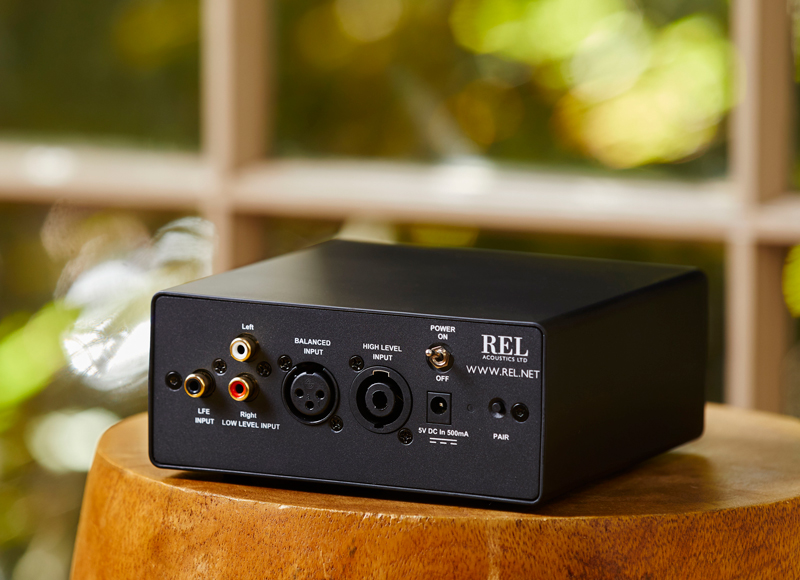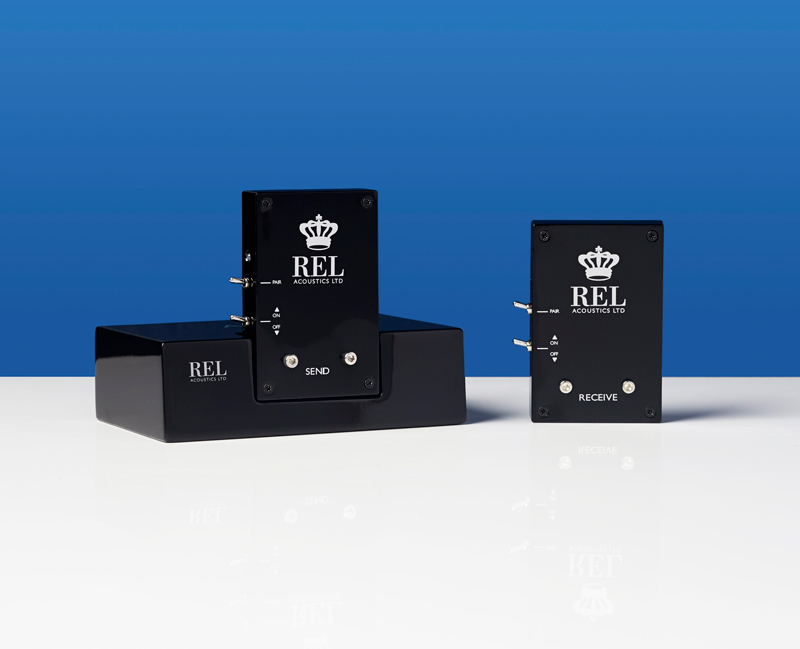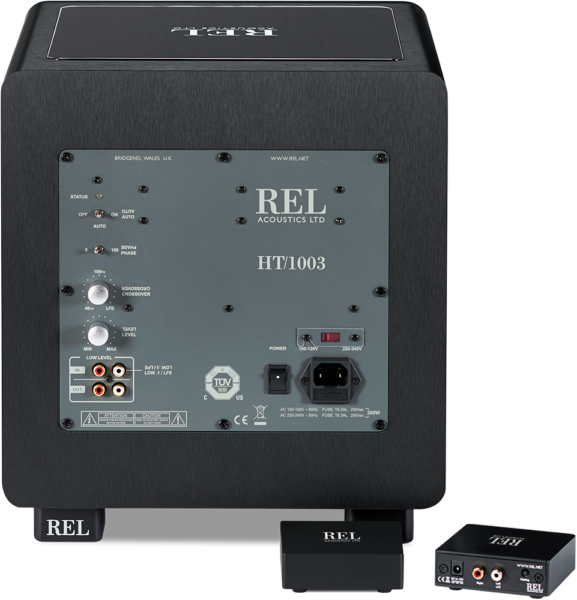Blog
Getting the Most Out of REL Wireless
Tips, Tricks & Best Practices for Wireless Subwoofer Connections

Our Wireless Systems for connecting our world class subwoofers to your amplifier or receiver have developed a similarly word class reputation among audiophiles the world over. This is because we pioneered the technology as the first subwoofer company to develop and bring to market zero compression ultra- fast wireless way back in 2010.
Back then, and still to this day, most are content to take off the shelf telephony Bluetooth-based wireless systems based on what was acceptable for the average cell phone. Not exactly high quality. Those early systems had latency, which we’ll dive into in a moment, measured in the 120 millisecond range. To put that into perspective, the average subwoofer wireless system of the last decade would slow down the delivery to approximately the delay if you took your own subwoofer, walked down to your neighbors two doors away, plugged it in and listened. Not a big surprise that performance was awful. Worse, by using massive digital compression schemes, the sound was thin and squashed.
In contrast then, our wireless systems had about 16-20 ms of latency. That’s a reduction of about 85%. Latency being the delay that results from taking in an analog (music or theatre) signal, running it through A-D encoders, then wirelessly transmitting the signal and finally receiving it and re-converting back to analog at your REL. Further, they were designed by a team of musicians and engineers to replicate full bandwidth (not just bass, but we use all the musical instruments to voice RELs) signals via a digital broadcast devoid of any compression.
So, instead of having to hear slow, completely out of time bass that lagged 2 beats behind the musicians like a bad drummer after too many glasses of scotch, we “placed” your REL within about 13-16’ feet, in other words about the distance that most people actually listening to their system from. And because we’ve never agreed to use compression, all the rich, explosive dynamics of our subs are delivered in the same way they would be if your RELs were hardwired.
And therein lies the rub, kind of. You see, in the decade or so since we revolutionized wireless subwoofer performance, the world has gone crazy for wireless. In many cases, they’re not even thought of as wireless. Their uses are so innocuous and helpful that items like Alexa probably aren’t even thought of as wireless. By 2023 (according to RCR Wireless), there will be some 22 billion wireless devices running worldwide. In the U.S. we own some 11 wireless devices per household in 2020, increasing to almost 14 per household by next year. The UK and Europe are not far behind. And that adds up to a lot of wireless clutter.

You see, at its root, any wireless device has a digital origin but ultimately the wireless aspect of it is not all that different than an old FM tuner and transmitter. And radio transmitters are notoriously noisy devices, that rather being their purpose. Which brings us back to REL’s super-fast, uncompressed wireless devices.
Rule #1, you cannot place a REL wireless next to another wireless device and hope for it to not interfere. Fast, uncompressed wireless means at least 3’ is required between wireless devices to reduce interference. “Why not?” you ask, sure of your position. After all, you have your broadband modem placed right next to your wi-fi home (hardwired) transmitter with Alexa cheerfully running right next to it, satellite nodes running in 3 locations scattered throughout your house. On the other side of your computer, a Sonos Bridge transmitter is humming happily along, your son’s, daughter’s and wife’s iPhones, iPads and other wireless Bluetooth devices are all pulling all manner of music, YouTube video, etc. out of the ether and doing something with it.
But those devices aren’t tasked with doing anything close the job our wireless transmitters have to perform. Not even close. You see, we’re tasked with being exactly in time and tempo with a music system that (in almost every instance) is hardwired between amplifier and speakers, possibly even hardwired to one REL subwoofer on the left of the room, while all agreed that using a REL wireless to get signal to the pesky right side of the room would be brilliantly solved by using REL wireless.
And so, this is our reality. We don’t have the digital crutch of being able to sample and resample and ultimately construct results out of digital data that has been pulled into buffers, examined endlessly until the computer decides the data stream is perfect. Nope, that cymbal swish happened RIGHT NOW on the (hardwired) music system and the right channel REL in our example has to deliver the soft thump-whoosh of the felt-covered mallet to a floor tom-tom right NOW. So, how can you set yourself up for success in this messy world of wifi (radio signals) running all around the same room as your music system?
Easily. First, stop and recognize that any “wireless” signal starts off as a wire running to a wireless transmitter. That means your REL wireless system is actually a hybrid of hard-wired and wired, and therein lies a solution to interference. Using the wired input to your REL transmitter, whether for LFE/.1 theatre signal or High Level Connection for music, realize this wire provides considerable flexibility of placement of your REL wireless transmitter.

Here’s a real world example; a friend (Michael) wanted to gift another friend with a pair of small RELs for favors he’d done. Having just bought a new home, and knowing his friend was a digital software engineer with wifi all over the place he asked for guidance. His friend’s system was located in a closet and the subs were to be on the other side of the room. After asking a few questions, I suggested he cut down the 10M (33’) high level cables supplied to around 3M (10’) and pick up a couple small white shelves from Ikea that show no hardware, they simply slide onto two small posts that reside within the thickness of the shelf. Placed above and to each side of the closet door, they were above a visual sightline and could beam unobstructed high-quality bass to the small REL’s placed along the opposite walls, tucked into corners.
In doing so, I actually solved a problem related to Rule #2. Human beings are largely made of water. This makes us terrible transmitters of wireless signals. Water absorbs wi-fi and any other wireless signal so people standing in the path of the signal are a real problem. Imagine having friends or family over and as they crowd into the room to hear your new pride and joy the bass suddenly goes intermittent. No need, if our transmitters are placed so as to both improve line of sight and to get above the height of the average person the entire wireless signal path for your REL becomes very robust. Simple as tucking them on top of built in cabinets.
So, our super-fast wireless units face challenges normal computer-based wifi never has to deal with because we can’t rely on buffering; music happens right now and we are often operating in a system where most of the system is hardwired so we cannot slow down to buffer. REL’s signal has to be functionally as fast as hardwired to preserve the sound quality and experience.










